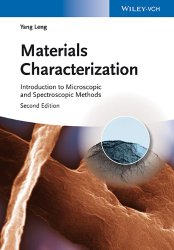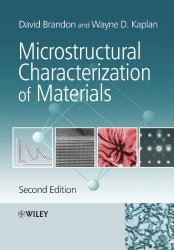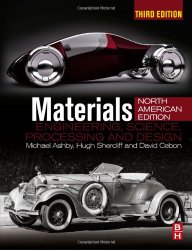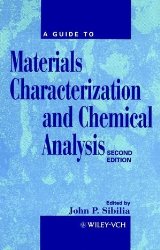 Materials Characterization: Introduction to Microscopic and Spectroscopic Methods
Materials Characterization: Introduction to Microscopic and Spectroscopic Methodsby Yang Leng
Publisher: Wiley-VCH
ISBN: 3527334637
Now in its second edition, this continues to serve as an ideal textbook for introductory courses on materials characterization, based on the author's experience in teaching advanced undergraduate and postgraduate university students.
The new edition retains the successful didactical concept of introductions at the beginning of chapters, exercise questions and an online solutions manual. In addition, all the sections have been thoroughly revised, updated and expanded, with two major new topics (electron backscattering diffraction and environmental scanning electron microscopy), as well as fifty additional questions - in total about 20% new content.
 Microstructural Characterization of Materials
Microstructural Characterization of Materialsby David Brandon, Wayne D. Kaplan
Publisher: Wiley
ISBN: 0470027851
Microstructural characterization is usually achieved by allowing some form of probe to interact with a carefully prepared specimen. The most commonly used probes are visible light, X-ray radiation, a high-energy electron beam, or a sharp, flexible needle.
These four types of probe form the basis for optical microscopy, X-ray diffraction, electron microscopy, and scanning probe microscopy.
 Materials Chemistry
Materials Chemistryby Bradley D. Fahlman
Publisher: Springer
ISBN: 9400706928
The 2nd edition of Materials Chemistry builds on the strengths that were recognized by a 2008 Textbook Excellence Award from the Text and Academic Authors Association (TAA).
Materials Chemistry addresses inorganic-, organic-, and nano-based materials from a structure vs. property treatment, providing a suitable breadth and depth coverage of the rapidly evolving materials field in a concise format.
 Transmission Electron Microscopy: A Textbook for Materials Science
Transmission Electron Microscopy: A Textbook for Materials Scienceby David B. Williams, C. Barry Carter
Publisher: Springer
ISBN: 0387765026
This groundbreaking text has been established as the market leader throughout the world. Now profusely illustrated with full color figures and diagrams throughout the text, Transmission Electron Microscopy: A Textbook for Materials Science, Second Edition, provides the necessary insight and guidance for successful hands-on application of this versatile and powerful materials characterization technique.
For this first new edition in 12 years, many sections have been completely rewritten with all others revised and updated. The new edition also includes an extensive collection of questions for the student, providing approximately 800 for self-assessment and over 400 that are suitable for homework assignment.
 Materials: engineering, science, processing and design
Materials: engineering, science, processing and designby Michael F. Ashby, Hugh Shercliff, David Cebon
Publisher: Butterworth-Heinemann
ISBN: 0080994342
This is the essential materials engineering text and resource for students developing skills and understanding of materials properties and selection for engineering applications. Taking a unique design-led approach that is broader in scope than other texts, Materials 3e meets the curriculum needs of a wide variety of courses in the materials and design field, including introduction to materials science and engineering, engineering materials, materials selection and processing, and materials in design.
This new edition retains its design-led focus and strong emphasis on visual communication while expanding its inclusion of the underlying science of materials to fully meet the needs of instructors teaching an introductory course in materials.
 Thermal Analysis of Polymeric Materials
Thermal Analysis of Polymeric Materialsby Bernhard Wunderlich
Publisher: Springer
ISBN: 3540236295
Thermal Analysis of Polymeric Materials systematically treats macroscopic measurements by thermal analysis and the quantitative link to microscopic, molecular structure and mobility. Reversible and irreversible thermodynamics, kinetics, quantum mechanics, and statistical thermodynamics are the roots of the described thermal analysis.
The book aims to broaden readers’ understanding of materials and the connection of flexible macromolecules (polymers) to small molecules and rigid macromolecules (minerals, salts, and metals). An effort is made to discover how the long, flexible molecules fit into their small phases which are characterized as microphases or nanophases. Their order ranges from amorphous to mesophase-like and crystalline. Ultimately, it is shown that the basic structure-property-processing triangle is connected to the better-known types of molecules and their common macroscopic phases.
 A Guide to Materials Characterization and Chemical Analysis
A Guide to Materials Characterization and Chemical Analysisby John P. Sibilia
Publisher: Wiley-VCH
ISBN: 0471186333
A Guide to Materials Characterization and Chemical Analysis Second Edition Edited by John P. Sibilia This book provides an overview of the most current techniques used for chemical analysis, materials evaluation, and materials testing.
Over 100 materials methodologies, evaluations, chemical analyses, physical testing, and scientific computing techniques are covered, including the fields of molecular spectroscopy, mass spectroscopy, chromatography, chemical analysis, x-ray analysis, microscopy, surface science, thermal analysis, and polymer characterization.
 Thermal Analysis of Materials
Thermal Analysis of Materialsby Robert Speyer
Publisher: CRC Press
ISBN: 0824789636
Discussing the design and optimum use of thermal analysis instrumentation for materials' property measurement, this work details how the instruments work, what they measure, potential pitfalls and the fitting of experimental results to theoretical models. It presents a tutorial on writing computer programs for data manipulation, advanced thermoanalytical methods and case studies.
 Biomaterials, artificial organs and tissue engineering
Biomaterials, artificial organs and tissue engineering Forensic Engineering Fundamentals
Forensic Engineering Fundamentals Nanostructures and Nanomaterials: Synthesis, Properties, and Applications
Nanostructures and Nanomaterials: Synthesis, Properties, and Applications